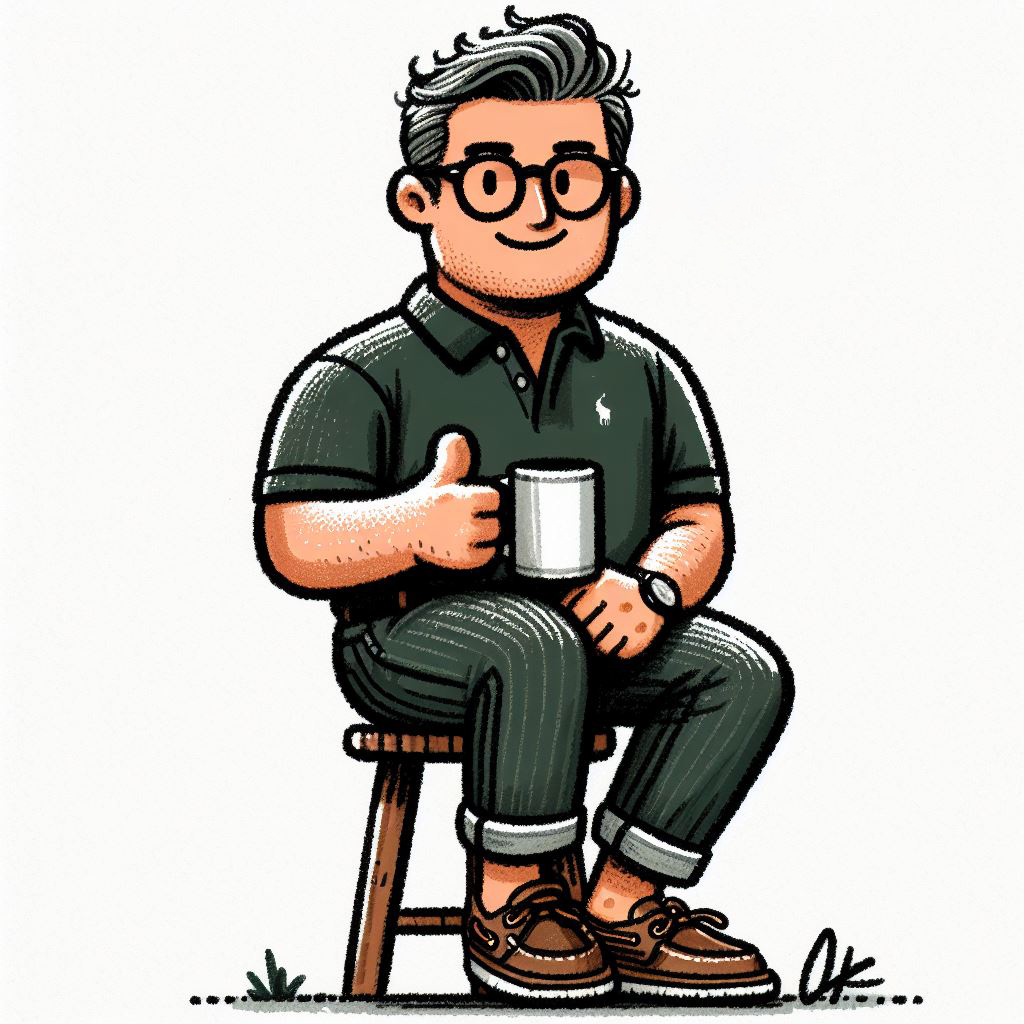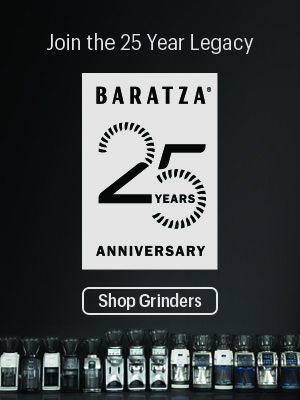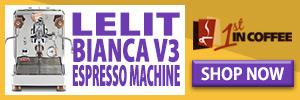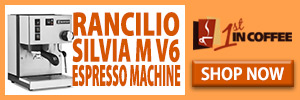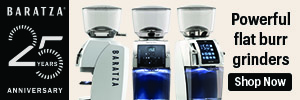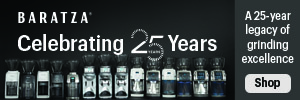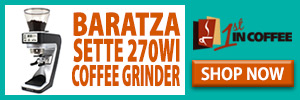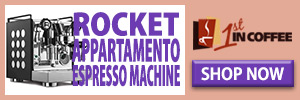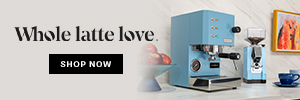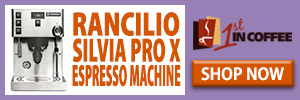As those of you who enjoy the front page content on CoffeeGeek know, updates and new articles have been few and far between this spring and summer. A lot of it has to do with a bit of stockpiling we’ve been doing – stockpiling words, stockpiling articles, how-tos, guides, reviews, you name it. Why stockpiling? Because all Spring and Summer we’ve been working on the newest version of this website, which we’ve been referring to as CoffeeGeek V3.
CoffeeGeek V3 Status
(ed.note 2021 – it’s painful for me to read this section again. So much time and effort lost with the V3 build of CoffeeGeek that never came to pass (I probably spent about $9,500 on that failed venture), but at least this article also covers the CoffeeGeek Lab)
We made some amazing progress on the V3 build during the Spring months – so much so that I truly felt we would be able to have a Sneak Preview of the new site as far back as April or May. The entire new site was sitemapped, wireframed, and designed on paper. Completely new sections – sections which I hope will contribute new things to how coffee and espresso is represented on the Internet – were planned, mapped out, drawn up and designed. Our most popular sections – namely the forums, detailed reviews and the guides and how-tos, were given a major revamp.
Sometime around April, the progress slowed to a crawl. Unforeseen circumstances with the design crew we hired plus another major event (more on that below) turned good solid progress into a glacial process.
As this summer progressed, design crawled to a halt. All I can do is apologise for that profusely, but also pass along the good news that programming, done by long time CoffeeGeek programmer Wayne Venables, has really started to roll. Wayne’s got some amazing technology planned for the new CG that will once again make everything we do on this website state of the art and pretty much unique. Our stalling point right now is design – or more specifically finishing up the design work started about 8 months ago, which leads me to the final point about this update.
For our regular readers, please skip down to the next section in this article – what you’re about to read next is a job-ad of sorts.
We’re currently looking for a new design crew on the html / css / creative design front. I will save details for private correspondence, but the short version is – much of the grunt work is done, but we need someone with excellent skills – in creative design, in state of the art html / css implementation, and with a great work ethic and communication skills. Ideally we’re looking for someone based in Vancouver, but would be willing to work with an out-of-town company or person. There are criteria, which I will be happy to send via email – so if you or your company is interested, please contact me through CoffeeGeek’s main email address, and I’ll send the full details.
The CoffeeGeek Lab

If you follow us on Twitter this is old news, but one of the biggest changes to happen to CoffeeGeek in some time is something physical, and not website based: in June, I started setting up a new coffee and espresso Lab in Vancouver. This isn’t the CoffeeGeek Lab of 2006 either. It’s a fully dedicated 55 sq. metre room filled with over 100 ways to make coffee and espresso, and dozens of ways to test and evaluate our favourite beverages.
My previous test labs for product evaluation, coffee tastings and cuppings were split across four areas – my home’s kitchen, a small corner of my photography studio, a small (9 sq.metres) room housing a La Marzocco espresso machine and various grinders, and my dining room where I held many cuppings and tastings, including the infamous N. America vs. Italy espresso taste-off. Not super professional, kind of a hack job really. I used to jokingly refer to these spaces as my “labs”, but gradually it got more serious in usage, and frankly, I was I a bit embarrassed to refer to these places as “the Lab”.
This year, that all changed. Over the summer I set up a dedicated Lab space that is divided into three zones – the Espresso Lab, the Coffee Lab, and the photography area. It is still very much a work in progress, but here’s the details.
The Espresso Lab
The primary workspace area in the Lab would always be dedicated to espresso. While it is trendy to “trash” espresso these days with so many of the third wave companies going all single origin and rediscovering traditional brewing methods – not that there’s anything wrong with loving all coffee brewing methods (anyone check the siphon coffee craze of late?) – here at CoffeeGeek, espresso is still seen as the epitome of extraction methods. It is also the method we (as an industry) know precious little about. While it may be easy to give up on espresso and go back to more traditional brewing methods, that isn’t what our website and our global community is about.
There are labs of different styles, resources and technologies around the world dedicated towards discovering more about espresso every day, and we wanted CoffeeGeek to be a more involved part of that. I wanted the Lab to be one of the best independent testing labs for consumer espresso machines, and much of the setup is geared towards that goal. I spent the summer revising our testing parameter documents – documents that regiment the testing process for a variety of machines and grinders. We even have some testing parameters set up for testing tampers and tamping stands – it is that detailed. We also wanted to remain true to what CoffeeGeek was all about – educating consumers about great, culinary coffee methods. So the Espresso Lab was set up with five missions:
- Espresso blend evaluation. In the Lab our primary machine for testing espresso is a La Marzocco GS/3 Paddle group model, with two grinders – a Compak K10 Conic for best-calibre, repeatable grinding quality, and a Anfim “Best” home grinder, representing the best of what is available for home use. We chose the GS/3 for several reasons. The machine is state of the art, with very precise, repeatable temperature controls. The machine is portable, meaning we can easily pack it up and use it for remote events and testing. It was vitally important to have an espresso machine that could be calibrated and consistent for testing espresso blends, and after a long search of what was available, the La Marzocco GS/3 paddle group model was an easy choice. CoffeeGeek will provide private blend evaluations in the future, but for now the main focus is on bringing our readers more precise information about the coffee blends out there designed for espresso.
- Espresso Machine Testing. CoffeeGeek gained some of its early fame because of the Detailed Reviews I used to write. I’ve gotten away from that over the years, (I had my reasons) but the new Lab was designed in part to allow me (and others) to start up the process again and provide a more structured system for evaluation. As such, the Lab has a lot built into it for this purpose. For example, the Lab has five independent 110v, 15amp power circuits installed (meaning we can run up to 10 machines at the same time). We have several “5 second analysis” shot glass sets available (Andy Schecter designed; I had a few more built locally). We have a Scace device for 58mm groupheads, and two pseudo-Scace devices (I prefer to call them Jarrett devices, named after Barry Jarrett, who hacked together some Gaggia rubber blind filter inserts into filter baskets) for accurate temperature testing. There are timers, scales, infrared temperature readers and calibrated beakers. There are dedicated writing areas for tasting notes. There are more professional, more scientific labs for machine evaluation around the world, but we think this one is pretty good, especially for consumer machines.
- Grinder Evaluation. Much like the espresso machine evaluation, this Lab is also set up for testing both consumer and professional grinders. Our test equipment includes sifters for finding grind particle sizes, a USB enabled digital electronic microscope, and a dedicated area for doing head to head grinder tests with up to six grinders at a time. We do have testing parameter documentation specifically for grinders and this CoffeeGeek Testing Method is constantly evolving.
- Consumer Education Classes. A big step for us this year is setting up the curriculum to provide six structured classes to consumers on espresso. With this in mind, the Lab is set up to seat six people comfortably in a class, and up to 8 people if we do some minor changes to the coffee side of the CoffeeGeek Lab. The classes are set up in three intensity levels and will be priced accordingly – the 100 level classes (101 and 110) are complete beginner classes for those who have never had espresso in the home before. It will be mainly a discussion on what espresso is, what are the most important elements in making good espresso, and a primer on what is available, machine wise, at different price points. Some basic training of espresso techniques will be included. The 200 level classes (201 and 210) will be a bit more expensive but will be the full hands on training sessions, teaching beginner and intermediate techniques. Very key is this – something no other training class does – we’ll be teaching people not only on the GS/3, but also on machines of the same calibre they have in their home. The 300 level classes won’t be cheap (probably over $100 each), but will be very advanced classes and I plan to bring in some top experts for parts of the classes, including latte art, advanced extraction techniques, espresso evaluation skills and more.
- Hospitality Industry Classes. It’s long been my passion and goal to get restaurants serving good coffee. It is a struggle – some of Vancouver’s top restaurants with awesome attention to detail on what they put on the plate struggle so badly when it comes to what they put in the coffee cup. I could teach a “how to” class on how to make good espresso but instead I’ve structured a curriculum to garner an appreciation for quality coffee and espresso. These classes are intended for restaurant senior staff, managers, bartenders, sommeliers and chefs, and are loosely called “epiphany moments in coffee”. As of this writing, I have three restaurants in Vancouver signed on for fall classes.
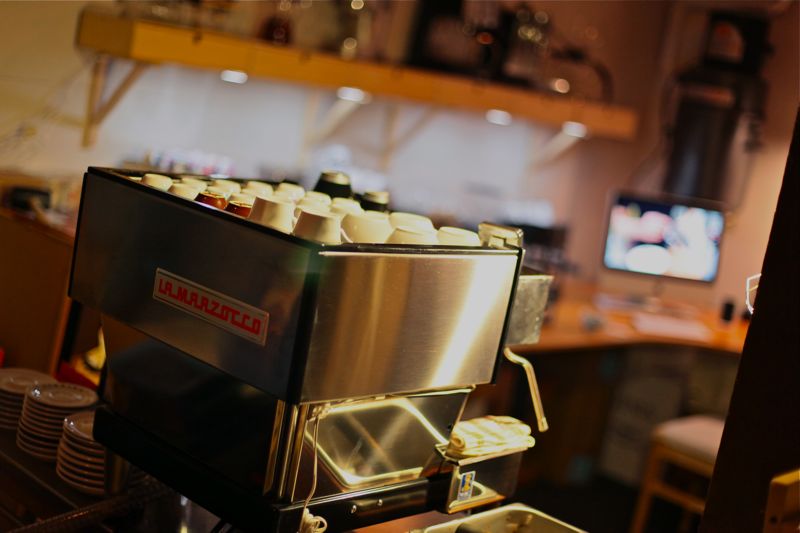
Before we got the GS/3 for the Lab, my rather unique FrankenLinea was the main stage machine used for early demonstrations.
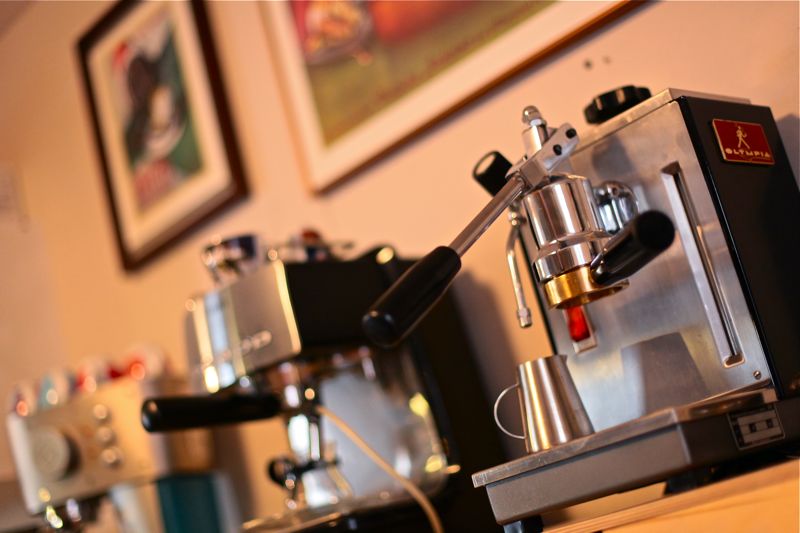
There are currently 10 consumer espresso machines plugged in, ready to brew with in the Lab, from $150 Krups models to $2000 E61 machines.
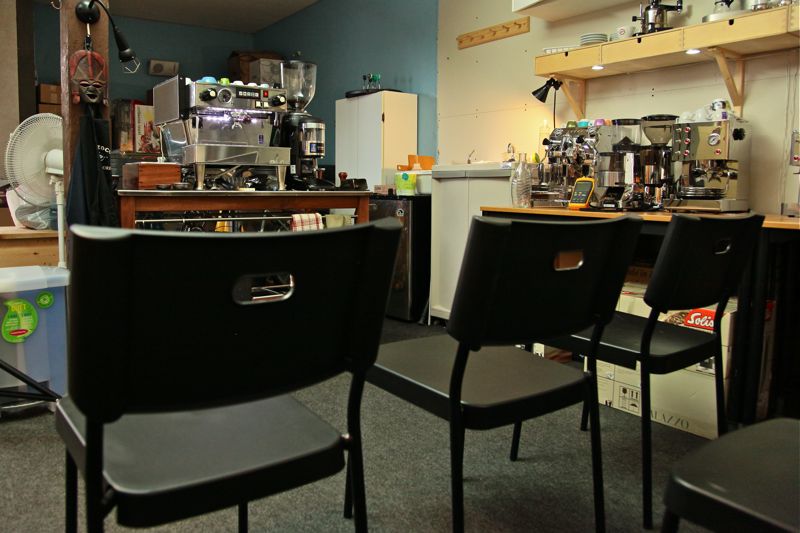
A view from the seats in an early layout of the Lab. We’ve since changed it a bit to accommodate more room for students.
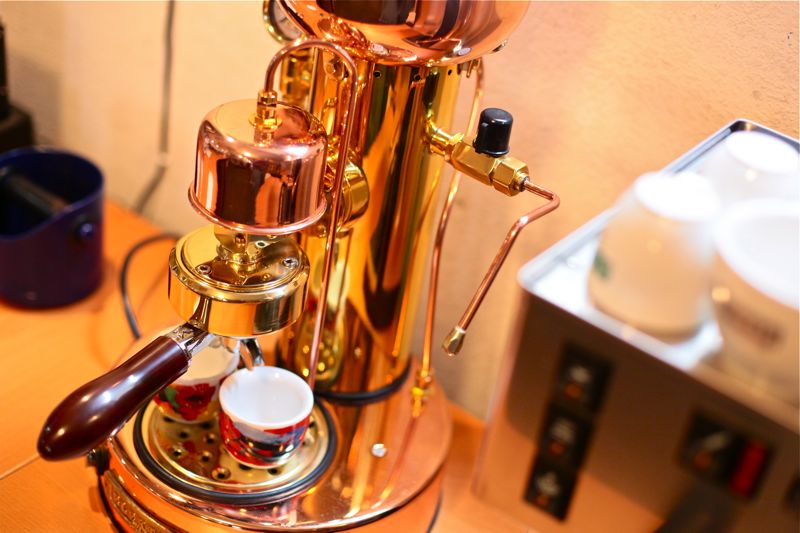
Besides the GS/3, this is one of the favoured machines in the Lab – nearly 10 years old now, it’s still shiny and 100% functional.
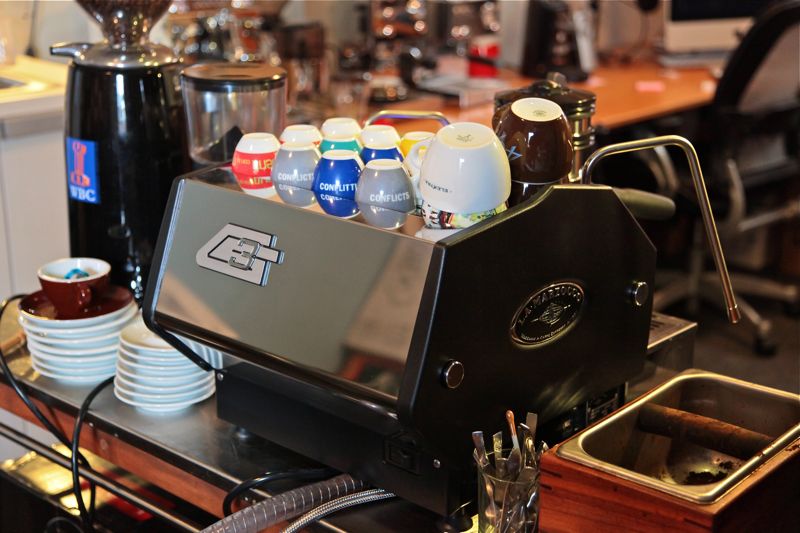
The front view of the GS/3 setup. We’ve made some minor changes to this area too, adding better lighting to focus on the espresso, and this may be plumbed in soon (ruining one of my Lab “favourite things” – see below).
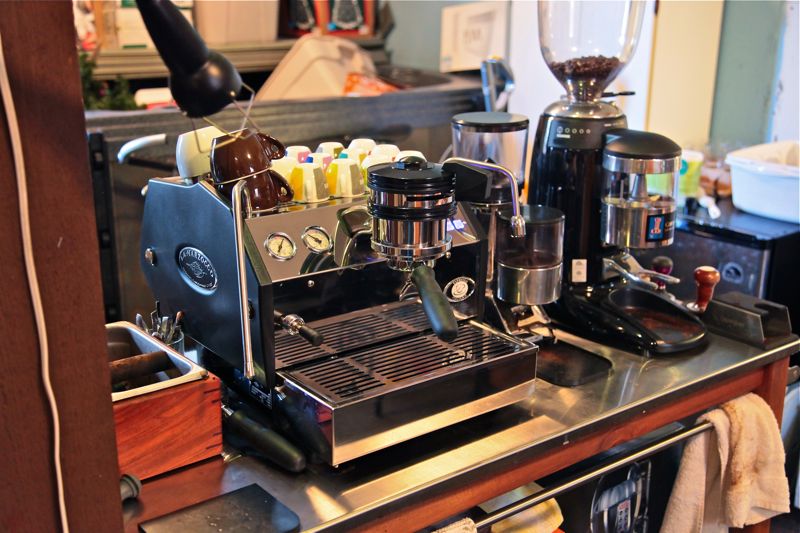
The front view of the GS/3 setup. We’ve made some minor changes to this area too, adding better lighting to focus on the espresso, and this may be plumbed in soon (ruining one of my Lab “favourite things” – see below).
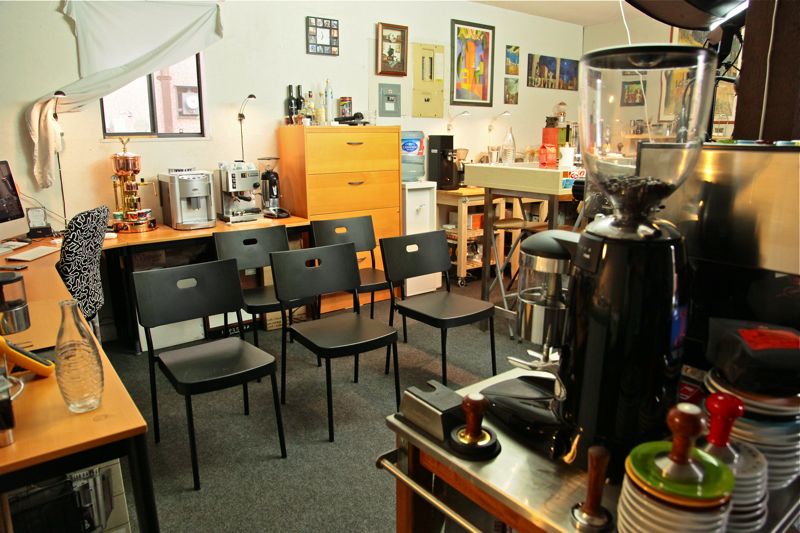
The early Lab seating arrangement for up to six people – we managed to get another few square meters of space through further rearranging, based on early visitor feedback.
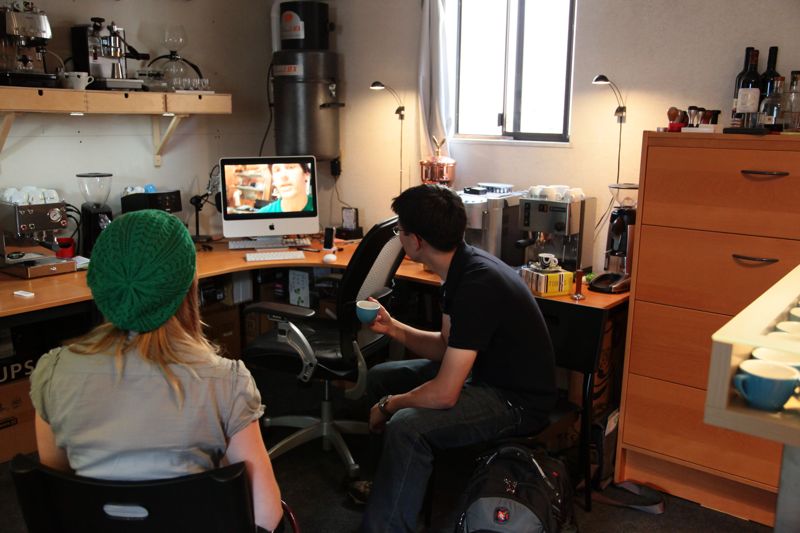
One of the most popular videos we played on the Lab Mac all summer long was Tom Owen’s “Drinking vs. Tasting” Youtube video. Here, two lab visitors are checking it out.
The Coffee Lab
When you walk into the Lab, you’ll find the area dedicated to coffee in the back-right corner. This space is intended to cover all brewing methods that don’t include espresso. The Coffee Lab has even more evaluation tools than the espresso side does, including calibrated scales, hot water towers, temperature measuring devices, and just about every brewing method available today for coffee. There are heavy influences on three areas – siphon coffee, press pot coffee, and formal cuppings. The Coffee Lab features a formal cupping table and has a fully stocked library.
There are four missions for the Coffee Lab:
- Coffee Evaluation. Much like the espresso lab has espresso blend evaluation as a mission, we evaluate a lot of coffees in the coffee lab. Some are done on private consultations, but many are for future use on the CoffeeGeek website – when we launch the new version of CoffeeGeek, coffee tasting notes will be a prominent part of the website. The Lab’s central cupping table can accommodate up to eight coffees at a time in a formal cupping, and all the usual cupping equipment is present. We also plan to hold informal coffee “tastings” much like how we did last year at Vancouver’s Bump n’ Grind cafe, inviting consumers in for monthly tastings. As a side note, we’re going to wire up the cupping table somewhat to host round table podcast recordings – but that is down the road a bit.
- Machine Evaluation. Similar to the Espresso lab, the Coffee Lab is set up to evaluate both grinders and coffee brewers of all types. We have dedicated spaces for doing head to head testing of drip brewers, siphon coffee makers, press pots, manual drip, and just about any other non-espresso brewing machine. The lab area includes sifters and grind particle checkers, dual hot water towers, a very capable Ditting KF804 grinder (with the latest milled burrs Ditting recently put out) and our lab all-purpose grinders: dual Baratza Varios. There is one thing conspicuously missing from the Coffee Lab – there are no ways to measure liquids in millilitres or litres – this is because we do all our liquid measurements with extremely accurate weight scales.
- Consumer Education. In the Coffee Lab, we have four classes planned as well as the aforementioned monthly coffee tastings – these classes will revolve around siphon coffee, press pot coffee, and general coffee appreciation. Two siphon classes are planned – a beginner introduction class and an advanced techniques class. The press pot coffee class will have a scope of beginner and advanced techniques, and the coffee appreciation class will be a general introduction to great coffee in the home.
- The Library. I’ve managed to assemble hundreds of books and magazines covering coffee and espresso over the years, and decided to set up many of them in the lab for reading on site by students. But that’s not all – there will also be a sign out system in place for CoffeeGeek Lab students, allowing people to take out various books for up to two weeks – much like a library. We have every copy of Barista Magazine, Roast Magazine, Imbibe, Cafe Culture, BeanScene, ever published. We have every copy of Fresh Cup Magazine going back to 2001. We have over 50 books on espresso, and nearly 75 books on general coffee techniques. There’s even a dozen fiction books revolving around coffee and / or espresso.

Here’s the early setup for the brewing station – Ditting KF804, twin hot water heaters, scales, and brewing apparati. I’ve since added a Vario grinder and better scale usage.

Having summer guests proved good – it was obvious that space was too confined around this showcase cupping table, and the table was too “busy”, There’s a lot more room now and the table is more clean.
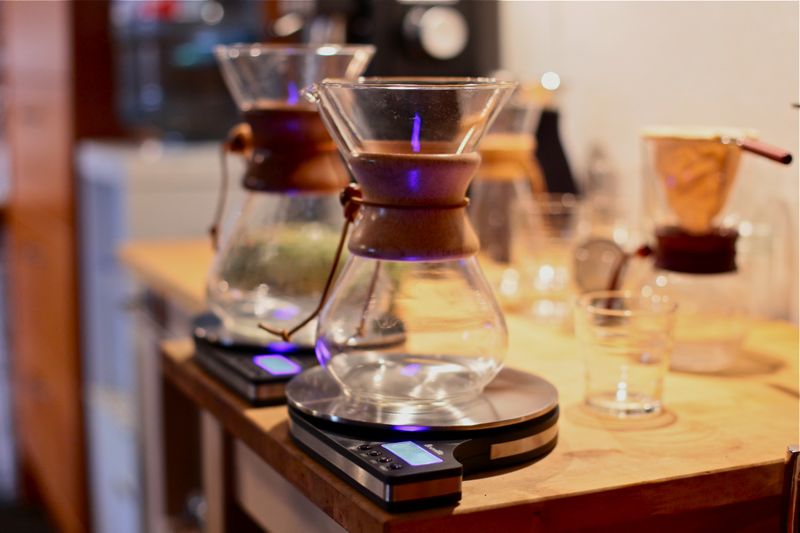
There are no visual measuring devices (measuring cups, etc) in the Lab – everything is measured by weight, including water. 1g=1ml give or take 0.05ml. These scales are particularly cool – they feature built in thermometers and digital timers.
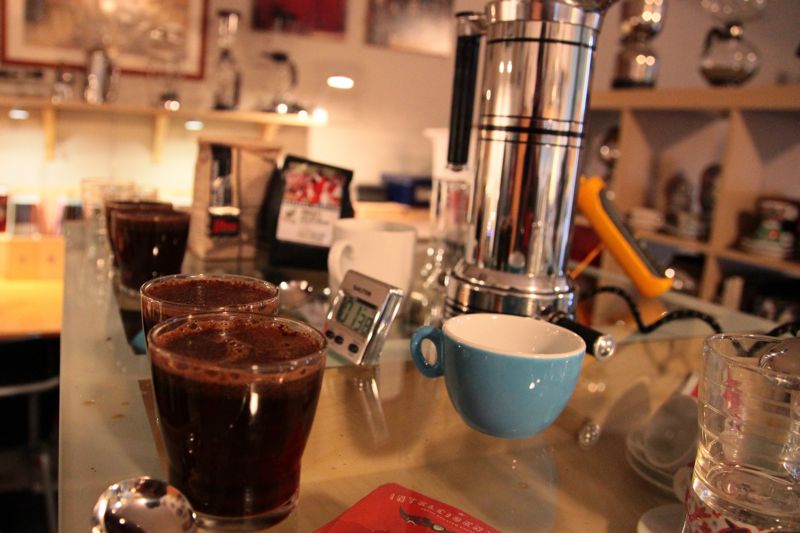
Only two weeks after declaring the Lab a “public beta” with visitors coming, we had our first formal cupping. The height of the cupping table – a reclaimed Ikea coffee table I put on a sturdy H-frame trellis – works well.
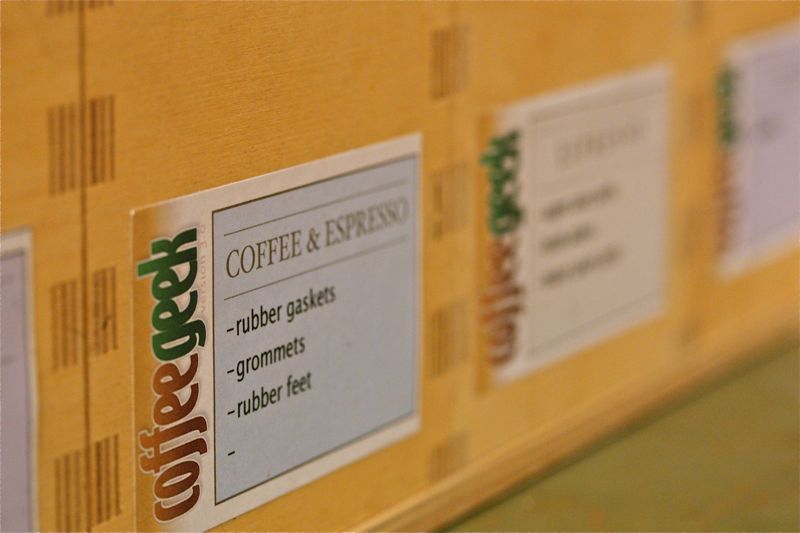
and hopefully everything in its place. All the storage drawers, cabinets, shelves and such are labeled and organized in the Lab.
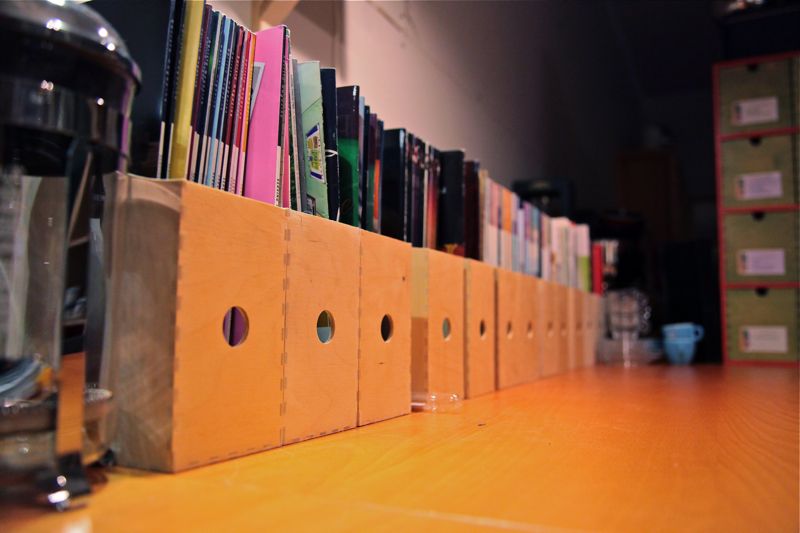
Seating for 3 at the Library area is in front of over 200 industry and trade magazines for coffee and espresso.
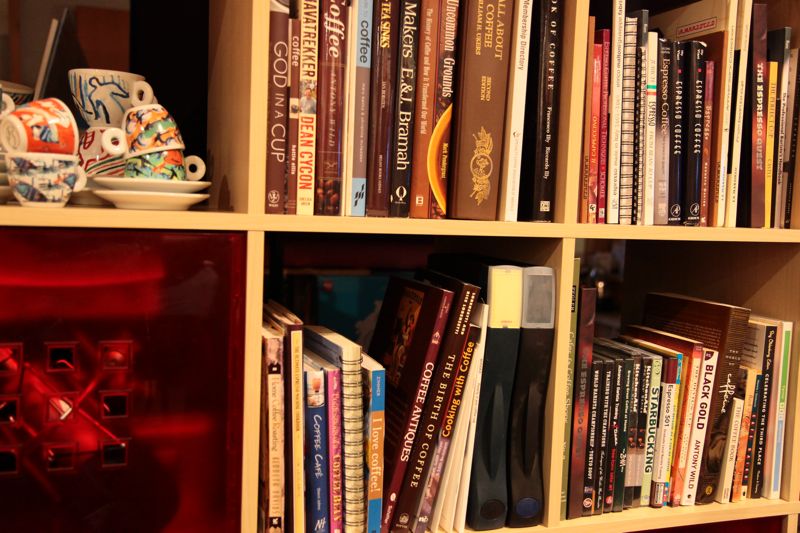
The CoffeeGeek Library currently has about 100 books on coffee and espresso that our students will be able to check out using a signsheet / honour system.
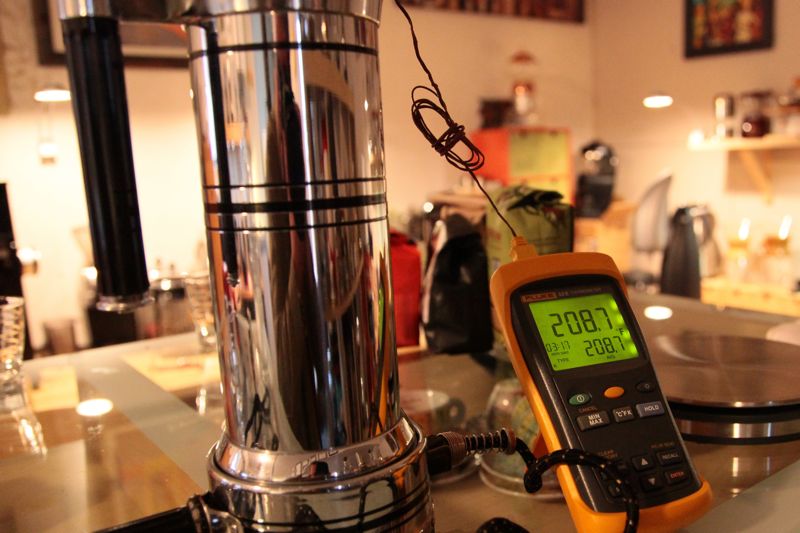
This is one of my favourite things about the Lab – a 1934 Sunbeam CoffeeMaster kettle / siphon brewer. We use it for all cuppings of three samples or less. Here, I am testing the temperature states of the brewer at various temperatures.

A definite star of the Lab for most visitors is the Hario Halogen Beam heater for siphon coffee brewing. I have a second on order too – the summer public beta showed a need for two units.

The Cupping table much cleaned up – less stuff under the glass. Visitors liked it this way, and it allows us to put the coffees being sampled under glass, right under the cups.
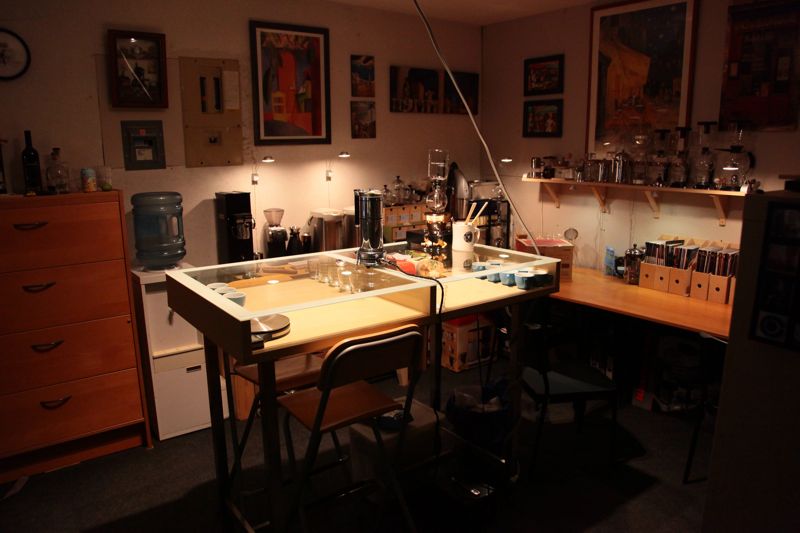
Lighting is very important in the Lab, and there’s a lot of targetted (and some diffused) lighting to throw focus where it needs be. When we’re cupping coffees, strong halogens are directly focused on the table. If need be, we can turn off all other lighting (via wireless remote!) to really reign in the focus.

When we’re not cupping coffee, the lighting in the Lab is very relaxed – inviting even – for reading in the Library or just sitting back and enjoying a cuppa.
The Photography Zone
Photography was definitely a big key to the early and continued success of CoffeeGeek.com. In the CoffeeGeek Lab, there is a dedicated photography space complete with three softboxes, interchangeable backgrounds, and a staging table only 1 metre away from the Lab’s GS/3 machine.
In the past, I struggled to give “as it happens” visuals of the espresso and coffee brewing process, but the new photography space in this Lab will make it easier than ever. It also provides a dedicated space for photographing all the equipment we test officially for the website’s First Looks, QuickShot Reviews and Detailed Reviews. We’re also set up now to do better video work and also for the podcast. What this means for you is better and better visual representations of the things you’ll be reading about on CoffeeGeek in the future.
Cool Lab Features
There’s a lot of things visitors over this past summer liked about the Lab, but I have to admit I have my own favourites. Here’s just a few.
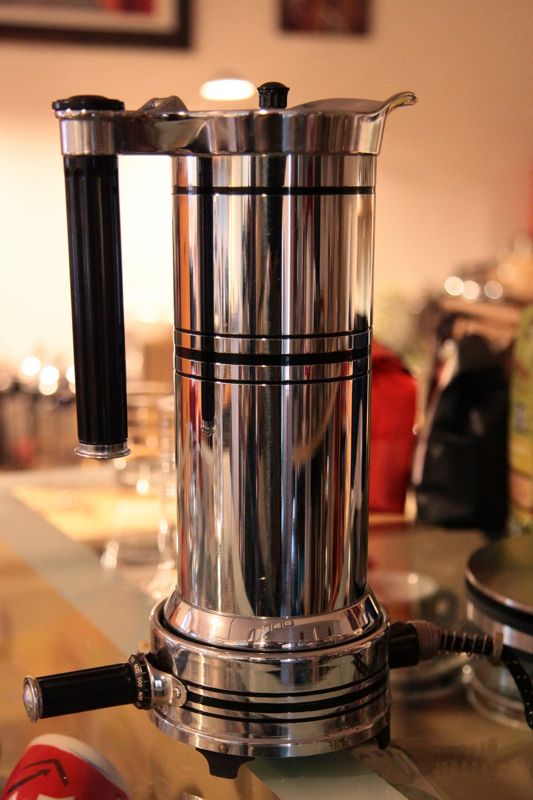
- Antique Kettle. Centre stage on the cupping table is a 1934 Silex “CoffeeMaster” vertical kettle with its own solid heating plate. It is the 1930s’ version of today’s cordless kettles. It features a very art deco look, is made out of solid copper wrapped in chrome and bakelite, and my favourite thing – the heating base features a stepless heat adjustment, via wattage – you can use as little as 100W (which keeps water warm but thats about it) right up to 700W (which would create a very big bubbling mess). My second favourite thing about this kettle is the pouring spout – it seems like it was designed for pouring into cupping glass samples – a nice gentle pour with a wide rim. The kettle holds enough water for six of our lab cupping glasses, or enough for cupping three samples. I’ve fluked it repeatedly and found that keeping the heat a tad over 400W will maintain 205F/97.5C water for up to 30 minutes (eventually it will slowly climb as water evaporates away).
- World’s Smallest Siphon Brewer. We have about twenty siphon brewers of various ages (including one from the late 1920s), but one of the more unique ones is a tiny brewer from Hario called the Miniphon. It’s not available in North America, but ordering it from overseas wasn’t too difficult. It brews – get this – 100ml of coffee, and its stature is about 1/3 the size of the next smallest siphon brewer we have: a Hario Technica 2 cup model.
- No plumbing… at all. I don’t know if this is cool, cruel, or sad, but the lab has no plumbing at all – When I took the space I assumed it did have some plumbing built in because of a particular feature I’d rather not get into, but nope, no plumbing. Yet we have massive amounts of water in the lab, a fully functioning sink, and several commercial machines. How does it happen? Well for water, every week the lab gets delivery of 15 gallons of Canadian Springs natural glacier water – this is for all the brewed / drinking water in the lab. We also have set up a water reclamation / collection system for our washing and utility water (though this dry summer in Vancouver has made that difficult). For washing up we have a self contained sink running off flowjets and a ginormous thermoblock for heating the water up to 130F. The commercial machines run off water bottle systems, and have awesome water running through them. It’s probably the only formal coffee testing lab in the world without running water… at least in industrialised nations.
- Siphon Emphasis. Long time readers of this site and CoffeeKid.com know how much I enjoy siphon coffee. The Lab shows this too, from the front-and-centre Hario Halogen burner (including step down transformers for the Japanese 100V power requirement) to the collection of antique and current siphon brewers all over the place. A recent addition is a siphon I’ve long wanted to own – a Twinbird self-contained Siphon and heating system, straight from Japan. Siphon is definitely king on the Coffee side of the Lab. That said, cupping and press pots are tied for a close second.
- Environmental nods. When setting up this Lab, especially knowing all water would be portable, I wanted everything to be as environmentally friendly as possible. We recycle everything we can, including a purpose built composting system for all our ground coffee waste (there’s a lot). We also use completely biodegradable, ground-safe cleaning products in both the machine cleaning and in our normal dish and cup washing. Because we have to empty our waste water from the sink and the machines running off water bottles, we want to make sure its all earth friendly. We even go so far as to switch water bottles when doing full cleaning on the espresso machines – the normal waste bottles get poured into our compost (they love that coffee-nutrient rich water), and the “cleaning solution” waste bottles (using enviro friendly cleaners like Urnex’s Total) go into the drain system.
An ongoing process
All summer long, I’ve been holding open, drop in sessions at the CoffeeGeek Lab for enthusiasts and professionals to drop in. They happened every Friday since June, and even some Thursdays. By my rough count, over 150 people have visited the Lab so far, and I was able to get some great feedback on how to better set up the space. As such, in the next 45 days, the Lab will be getting some fine tuning, and will probably be ready for some trial classes in early November 2009. Right now, the space is probably 80% completed to where I want it. Come November, it should be fully functional and a busy hive of coffee and espresso excitement.
There will be more to come regarding the CoffeeGeek Lab, including a dedicated part of this website, so please stay tuned – personally, I’m very excited by it all, and can’t wait to see where it will all go!


